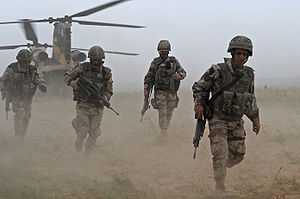Paratrooper Brigade (Spain)
| Brigada de Infantería Ligera Paracaidista | |
|---|---|
 Spanish Paratroopers in Afghanistan | |
| Active | October 17, 1953 - present |
| Country |
|
| Branch |
|
| Type | Airborne Forces |
| Role | Airborne Infantry |
| Size | 3,000 |
| Garrison/HQ |
Madrid Murcia |
| Nickname | Paracas |
| Motto |
¡Desperta Ferro! ¡Triunfar o Morir! (Succeed or die!) |
| Anniversaries | October 17 |
| Engagements |
Rif War Ifni War Yugoslav Wars Afghanistan War Iraq War Lebanon War Bosnian War Kosovo War |
| Commanders | |
| Notable commanders | Tomás Pallás Sierra |
The Paratrooper Brigade[1] (also known as the Airborne Light Infantry Brigade "Almogávares" VI or BRIPAC) is an airborne brigade of the Spanish Armed Forces forms part of the countries light infantry forces, called Black Berets.
Today is considered one of the quintessential elite units of the Spanish Army, along with the Spanish Legion.
Combat capabilities
Currently the BRIPAC is a unit with a high degree of professionalism and very high morale and training, ready to deploy at any time and place.
- Rapid deployment.
- High availability - two GT, s.
- Joint-combined operations
- Involvement vertical.
- HALO / HAHO (high altitude parachute jump).
- Operations developed land.
- Peacekeeping operations.
- Limited fire support
Capabilities CIMIC (Civil - Military Cooperation)
- Evacuation Control Center.
- Reception Center (refugee camp)
- Humanitarian corridors
- Civil Support Emergency Planning
- Public information
Organization and mission
The BRIPAC comprises the following units:
- Battalion Headquarters
- Parachute Banderas (commands)
- Artillery Group (GACAPAC)
- Parachute Engineers Battalion (BZPAC VI)
- Airborne Logistics Group (GLPAC VI)
- Airborne Transfer Company (CIATRANSPAC VI)
As a light infantry unit, it is designed to operate autonomously behind enemy lines, without relying on fire support and the corresponding risk of friendly fire casualties.
The Brigade consists of soldiers trained and equipped to operate as a key element for force projection, or in a framework for the creation of tactical groupings. Their specialty allows enough flexibility to function across the spectrum of conflict.
The BRIPAC is articulated in a Brigade Headquarters and a number of, fixed in each, small-unit combat, combat support and combat logistical support units. Those small combat units are:
- 1st Parachute Light Infantry Btn. "Roger de Flor" (BPAC-I)
- 2nd Parachute Light Infantry Btn. "Roger de Lauria" (BPAC-II)
- 3rd Parachute Light Infantry Btn. "Ortiz de Zarate" (BPAC-III)
The HQ, in addition to the corresponding functions in relation to the control, use and preparation of the Brigade, and employment of its units, is suitable for use in the command structure operating at any given moment. Properly reinforced, it can be at the command of a brigade-level operational organization of national or multinational scope.

To accomplish these missions, the BRIPAC develops an extensive and demanding training program, allowing its members to deploy the following capabilities:
- High availability (permanently available in two tactical groups)
- Rapid deployment (preparing in 72 hours for deployment anywhere in the world)
- Joint operations
- Airborne, air assault operations
- HALO operations
- Developed land operations
- Noncombatant evacuation
- Humanitarian aid
- Peacekeeping
Training
Training prepares its members to perform the following types of missions:
- Airborne operations
- Airmobile operations
- Noncombatant evacuation (NEO).
- Operations abroad
- Combat operations as standard infantrymen
- Capabilities paratroopers ET.
Courses
- Continuing Education Day: Exercises of about 30 hours in order to perform a demanding and intensive instruction in all tactical positions.
- Alfa-Exercises: Exercises four days used to complete the instruction section and coordinate the preparation of the various units of the Company.
- Beta-Exercises: Exercises of varying length where the Flag type unit / group coordinates the development achieved by the Cia. and integrates as a whole unit, thus achieving the tactical capabilities needed to fulfill the tasks assigned.
- Bilateral Exercises: Exercises paratroopers cooperation with other countries that serve for the exchange of knowledge, skills and experiences.
- Other Courses: In addition to the above described, the BRIPAC develops other exercises and maneuvers with other Army units in order to unify the operating procedures of the various support units such as Practice School of Artillery, Sappers or transmissions.
Casualties
- Killed in Action: 47, including 6 KIAs in Lebanon in March 2007 and in Afghanistan in 2006 (1) and 2007 (2)
- In Accidents: 71
- Deceased on active duty: 65 [1]
References
- ↑ 1.0 1.1 "Pagina oficial Ejercito de Tierra Español". Retrieved January 5, 2012.